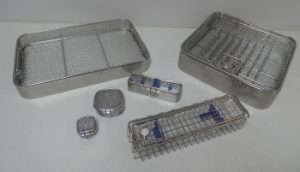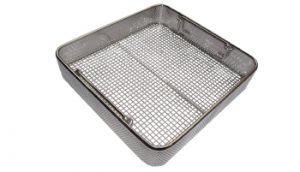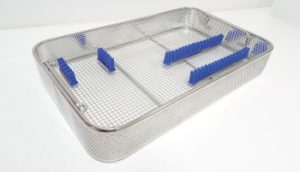Understanding sterilisation trays for CSSDs
Some questions answered about sterilisation trays/baskets for sterilisation departments
What are sterilisation trays made from?
Most sterilisation trays are now made from 304 stainless steel that is electrolytically polished. Sterilisation trays can also be manufactured in plastic but this isn’t as common.
What are sterilisation trays used for?

Sterilisation trays are used to store, hold and transport instruments, scopes and other theatre equipment during the cleaning and sterilisation process. The cleaned instruments are placed in a sterilisation tray and then placed in a steriliser. The sterilised instruments remain in the sterilisation tray and this is transported to a sterile store room ready for theatre.
What are the common sizes of sterilisation trays?
The most common sizes of sterilisation trays are DIN sizes. DIN sizing refers to a German Standard (DIN EN 285: 2016) which specifies requirements and the relevant tests for large steam sterilisers primarily used in health care for the sterilisation of medical devices.
When referencing DIN standards in Australia, it would be used to describe the size of a basket used within a batch washer/steriliser. A batch washer/steriliser would be described with a having a certain DIN capacity. The aim is to fit a certain number of DIN sized baskets easily into a DIN sized batch washer/steriliser.
| DIN Reference | Size – width |
| Full DIN | 480mm (sometimes also known as 500mm/515mm/540mm) |
| Three Quarters DIN | 360mm (sometimes also known as 400mm/405mm) |
| Half DIN | 240mm |
| One Quarter DIN | 120mm |

The trays can be any length and depth/height but the most common lengths referred to is 250mm. So common DIN tray sizes would be 480 x 250 x 50mm, 240 x 250 x 50mm, as well as combining DIN sizes together as width and length – 480 x 360 x 50mm, 240 x 120 x 50mm.
What styles of sterilisation trays are available?
Sterilisation trays can come in various shapes and sizes. The most common style is with perforated sides, wire mesh sides or micro mesh. Sterilisation trays can come with a lid attached or this can also be separate. The larger sterilisation trays usually come with handles which can retract into the tray when not in use.
How do the instruments remain in place in the tray?

The instruments can be secured with silicone holders, with each end inserted into a silicone insert so it won’t move during the sterilisation process. They can also be secured with a lid, pins and clips or silicone mats.
Do sterilisation trays meet AS4187:2014 standards?
Sterilisation trays must be validated by the sterilisation department to be used within a CSSD. This is usually done on a CSSD-hospital based level using existing trays. It is usually then determined if new trays are required to meet the Standard.
To find out more about the NSC sterilisation trays and basket range, click here

